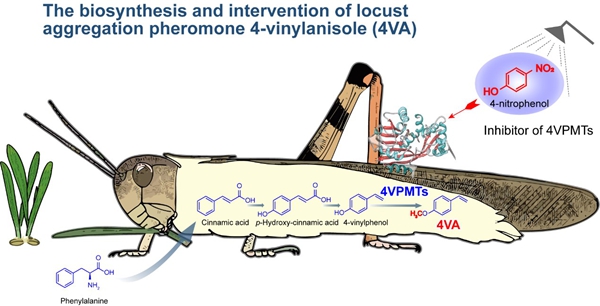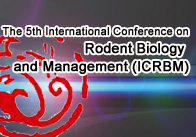On June 25th, Beijing time 23:00, 2025, the international top academic journal Nature published online the latest research discovery completed by the team of KANG Le from the Institute of Zoology, Chinese Academy of Sciences, in collaboration with LEI Xiaoguang's team from Peking University, titled "Decoding 4-vinylanisole biosynthesis and pivotal enzymes in locusts." This study makes it possible for humans to intervene in the aggregation and swarm migration of locusts. The research team first determined that the synthetic substrate of 4VA is derived from plant phenylalanine. Subsequently, using KEGG combined with the metabolic pathway of phenylalanine, two chemically logical 4VA synthetic pathways were predicted. By feeding or injecting stable isotope-labeled candidate intermediates and detecting whether isotopically labeled 4VA is produced, the synthetic pathway of 4VA in the migratory locust was ultimately determined to be: phenylalanine (Phe) - cinnamic acid (CA) - p-hydroxycinnamic acid (p-HCA) - 4-vinylphenol (4VP) - 4VA. The conversion of Phe-CA- p-HCA occurs in the gut, and p-HCA leaves the gut to spread through the hemolymph and is converted into 4VP, which is ultimately synthesized into 4VA and released outside the body. In addition, locusts can rapidly obtain Phe, CA, and p-HCA (key compounds in lignin synthesis) directly from plants, and only need to focus on the final conversion of 4VP and 4VA. Since solitary locusts do not produce 4VA, which intermediate compounds lead to the production of 4VA only in gregarious locusts? The results showed that Phe, CA, p-HCA, and 4VP can be detected in different tissues of both gregarious and solitary locusts. Feeding or injecting deuterated precursors to solitary locusts did not produce deuterated 4VA, indicating that the key difference in 4VA synthesis between gregarious and solitary locusts lies in the synthesis process from 4VP to 4VA. The chemical transformation from 4VP to 4VA is mediated by a methylation reaction catalyzed by methyltransferases. Through transcriptome analysis, quantitative experimental validation, in vivo interference, and in vitro enzyme activity assays, two key methyltransferases, 4VPMT1 and 4VPMT2, were identified and validated to control the conversion of 4VP to 4VA in locusts. The mRNA and protein levels of 4VPMT1 and 4VPMT2 can positively respond to changes in locust population density. After joint RNAi interference of 4VPMT1 and 4VPMT2, the release of 4VA significantly decreased, and gregarious locusts showed a significant shift towards solitary behavior. These results indicate that 4VPMTs are the molecular switches for 4VA biosynthesis. To further reveal their catalytic functions, the authors resolved the crystal structure of the 4VPMT2-4VP-SAM ternary complex. Analysis of the binding conformation and site-directed mutagenesis experiments confirmed that 4VP forms a Pi-Pi interaction with the aromatic amino acid residue H137 in 4VPMT2. Through structural modeling, molecular docking, dynamic simulation, and site-directed mutagenesis experiments on 4VPMT1, it was found that the binding of 4VP is stabilized by some hydrophobic residues V278 and M203. At the same time, Y61 forms a hydrogen bond with the phenolic group of 4VP. Additionally, 4VP forms a Pi-Pi interaction with the aromatic amino acid residue W174 in 4VPMT1, indicating that W174 plays a key role in the high activity of 4VPMT1. To develop an effective inhibitor of 4VPMTs, the research team designed and identified dozens of 4VP analogs to inhibit the methylation activity of 4VPMTs. Among them, 4-nitrophenol (4NP) can inhibit 4VPMT1 and 4VPMT2 at very low concentrations in vitro. Moreover, compared with 4VP, 4NP has a lower KM value for 4VPMT1, indicating a higher binding affinity, making it an effective substrate competitor to inhibit 4VA production. To study the effect of 4NP on 4VPMTs in vivo, different concentrations of 4NP were injected into gregarious locusts. The results showed that at an injection concentration of 0.1 nmol, 4NP could significantly inhibit the production of 4VA. Furthermore, after feeding gregarious locusts with wheat sprouts sprayed with 4NP, the release of 4VA significantly decreased, and the behavior of gregarious locusts significantly shifted towards solitary behavior. Similarly, after feeding 4NP, the release of 4VA in solitary locusts treated with gregarization significantly decreased, and the solitary locusts treated with gregarization still exhibited solitary behavior, while the control group exhibited significant gregarious behavior. These results indicate that 4-nitrophenol can effectively inhibit the gregarious behavior of locusts. This study not only reveals the molecular mechanisms of locust aggregation pheromone biosynthesis but also lays a solid scientific foundation for the development of pheromone-based precise pest control, opening up a new path for the construction of a pest green control system in agriculture. 
Figure. The biosynthesis and intervention of locust aggregation pheromone 4-vinylanisole (4VA)(image by Kang’s Lab)
|

